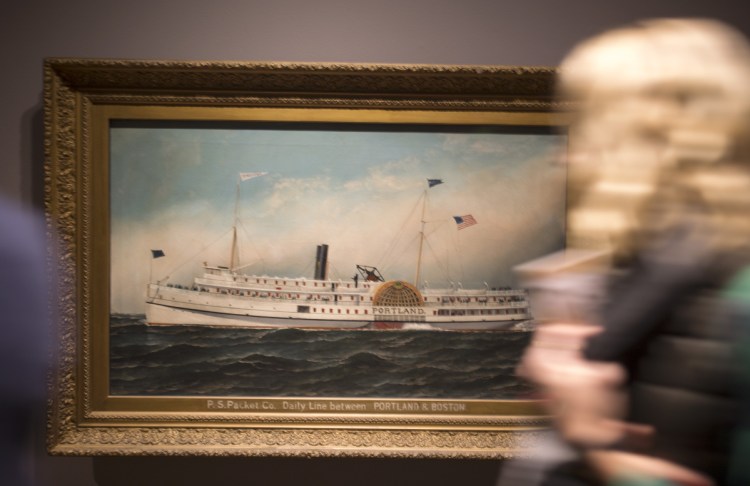The sky in Portland was a ghastly yellow on the evening of Nov. 26, 1898, and the captain of the steamship SS Portland was urged to stay at port in Boston because of the ferocious, rising seas. But the warning came too late, and in the early evening on the Saturday after Thanksgiving, the Bath-built steamship, one of the finest of its day and a stout 281 feet, set out for Portland in the icy waters of the Atlantic.
It had made this journey faithfully in the decade since its launching in 1889, carrying thousands of passengers and tons of cargo between Boston and Portland and earning the reputation as a dependable steamer. But it sailed into a massive gale that evening, and sometime in the early morning hours of Nov. 27 the SS Portland went down off Cape Ann, near Gloucester, Massachusetts. Everybody on board died, believed to be 192 people.
It remains the largest loss of life in a single sea storm in New England history. It was devastating to many Maine families, and particularly to Portland’s African-American community. Among those who died were 17 members of the Abyssinian Meeting House, Maine’s first black church and the third-oldest in the country. Many of the Abyssinian members who died worked on the ship as baggage handlers and coal-heavers.
“Death is a grim democracy,” said historian Herb Adams, who will talk about the shipwreck in a public lecture this week. “They all went to the bottom of the ocean, without distinction.”
Portland was home to fewer than 300 African-Americans at the time, and a score vanished in a single night. It was a devastating blow. Within 20 years, the Abyssinian dissolved, its members down to just a few.
With the 120th anniversary of the tragedy this month, the story of the ship and its loss will get a timely retelling. The Portland Museum of Art recently announced it had acquired the painting “The Portland,” a classical ship portrait by Antonio Jacobsen showing the stately white wooden vessel moving swiftly through the sea, and Adams will discuss the calamity Thursday at the Masonic Temple in downtown Portland in a talk titled “The Wreck of the SS Portland: And the Sea Shall Take Them All.”
“There wasn’t a stratum of Maine society that didn’t take a blow,” Adams said of the shipwreck. “The tragedy was so sweeping, there was hardly a church in Portland that didn’t have empty pews the Sunday after the sinking. A century-and-a-quarter has reduced none of the emotional impact of the story.”
The Jacobsen oil painting of the palatial paddle wheel, completed in 1891, had previously been on long-term loan to the museum. The PMA now owns it as a result of a recent gift from donor Walter Goldfarb. It’s on view on the second floor of the Payson Wing with wall text explaining the impact of the shipwreck on Portland’s African-American community at the turn of the 20th century.
The steamer was one of New England’s largest and most luxurious, accommodating up to 800 passengers. In the detailed portrait, the Portland’s gilded eagle perched atop the wheelhouse is clearly visible. Jacobsen doesn’t show them, but it’s easy to imagine the mahogany sofas and embroidered carpets of the Grand Salon. The side wheel is churning up the sea, and passengers on three decks seem to be enjoying the journey.
The artist placed the ship squarely in the center of the composition, suggesting the speed and power as the ship cuts through the sea.
Diana Greenwold, the museum’s associate curator of American Art, said the painting offers the chance to tell an important piece of Portland history. It’s a traditional ship portrait, she said, and so much more. “It’s a small painting, but we saw this as an opportunity to tell the human story behind it,” Greenwold said.
Jacobsen was among the best-known maritime painters of his time. He was born in Denmark, and painted thousands of ship portraits over a long career. He moved to the United States in the 1870s.
The shipwreck is among the best preserved in New England. The wreckage was discovered in 1989, photographed extensively in 2002 and placed on the National Register of Historic Places. It rests upright on the mud bottom of the Stellwagen Bank National Marine Sanctuary, its wooden hull nearly intact from the keel to the main deck level. The superstructure is missing. Small artifacts are scattered inside and outside the hull.
“After the ship was struck by the wave that killed it, it sank like a leaf falls from a tree, so gently that stacks of dishes slid gently from the table,” Adams said.
Send questions/comments to the editors.




Success. Please wait for the page to reload. If the page does not reload within 5 seconds, please refresh the page.
Enter your email and password to access comments.
Hi, to comment on stories you must . This profile is in addition to your subscription and website login.
Already have a commenting profile? .
Invalid username/password.
Please check your email to confirm and complete your registration.
Only subscribers are eligible to post comments. Please subscribe or login first for digital access. Here’s why.
Use the form below to reset your password. When you've submitted your account email, we will send an email with a reset code.